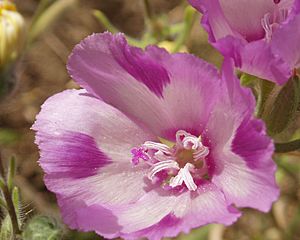Clarkia williamsonii facts for kids
Quick facts for kids Clarkia williamsonii |
|
|---|---|
 |
|
| Scientific classification | |
| Genus: |
Clarkia
|
| Species: |
williamsonii
|
Clarkia williamsonii is a beautiful flowering plant that grows only in California. It is often called a type of "farewell-to-spring" flower. You can find it in the forests and woodlands of the northern and central Sierra Nevada mountains.
What Does It Look Like?
This plant is an upright annual herb. This means it grows from a seed, flowers, and dies within one year. It has long, thin leaves, usually a few centimeters long.
The plant produces many flowers. When the flowers are still buds, they are mostly closed. Only the very tips are open, where the sepals (the leaf-like parts that protect the bud) do not join together. As the flower opens, these sepals either separate completely or stay joined in pairs.
Each petal of the flower is shaped like a fan and can be up to 3 centimeters long. They are usually a lovely lavender color. In the middle, they have a white area with a purple spot. Sometimes, the petals can be a solid deep red color instead.
Interesting Facts About Its Genes
Clarkia williamsonii has a special feature in its genes. Scientists have found that some populations of this plant have a unique way their chromosomes are arranged. Chromosomes are like tiny packages inside cells that carry all the instructions for how a plant grows.
In the foothills of California, almost half of these plants have a special arrangement of their chromosomes. But in the higher parts of the mountains, this special arrangement is much less common, found in fewer than 10% of the plants. This difference helps scientists learn more about how plants adapt to different places.

